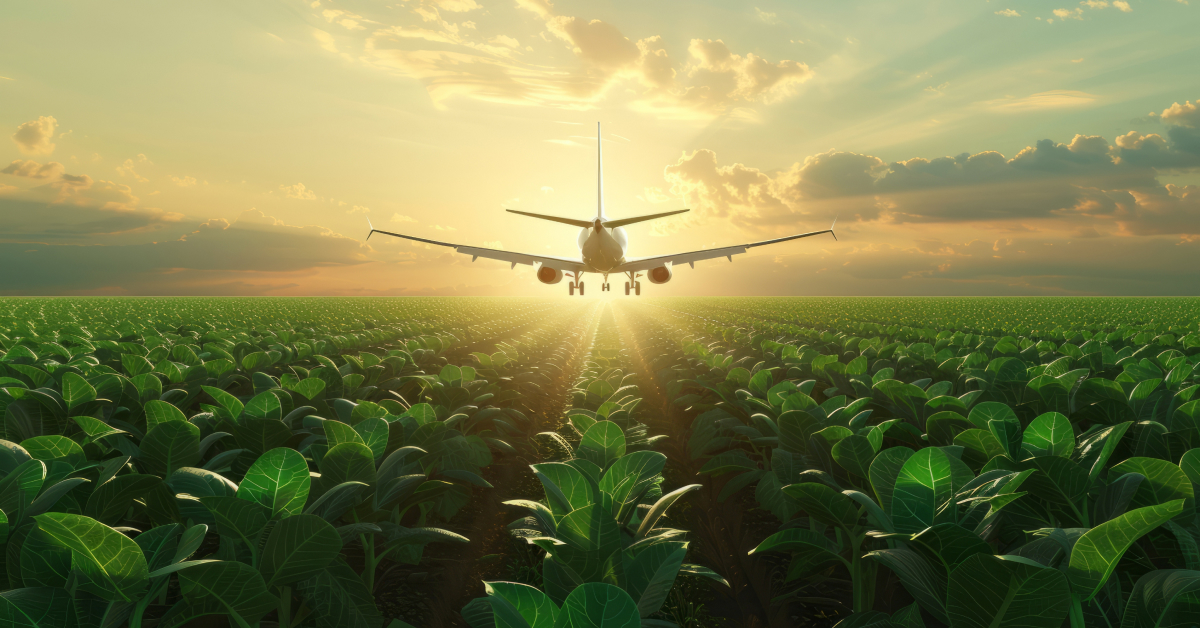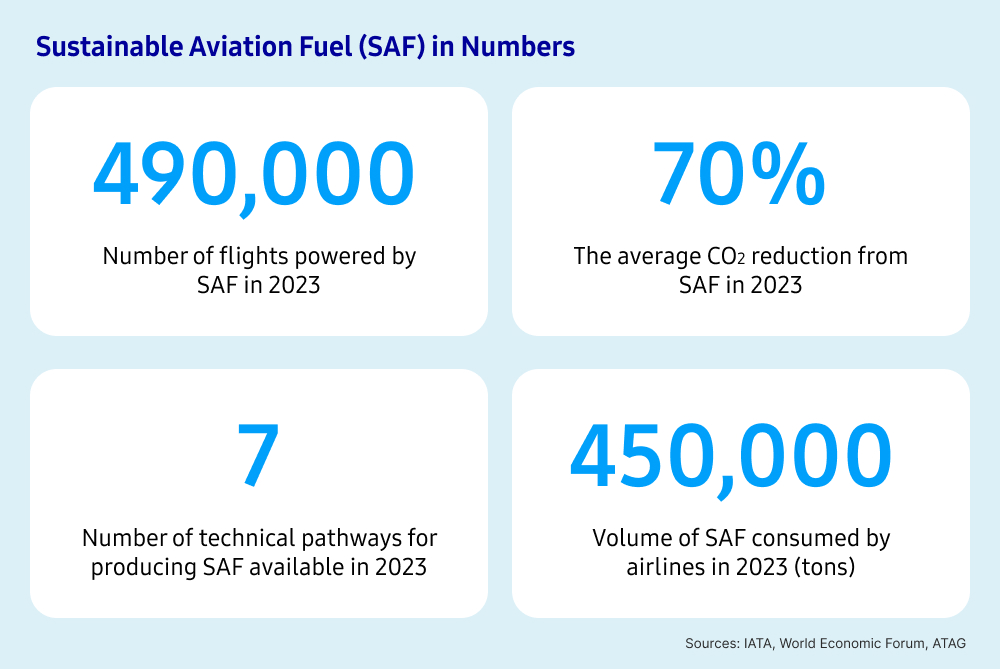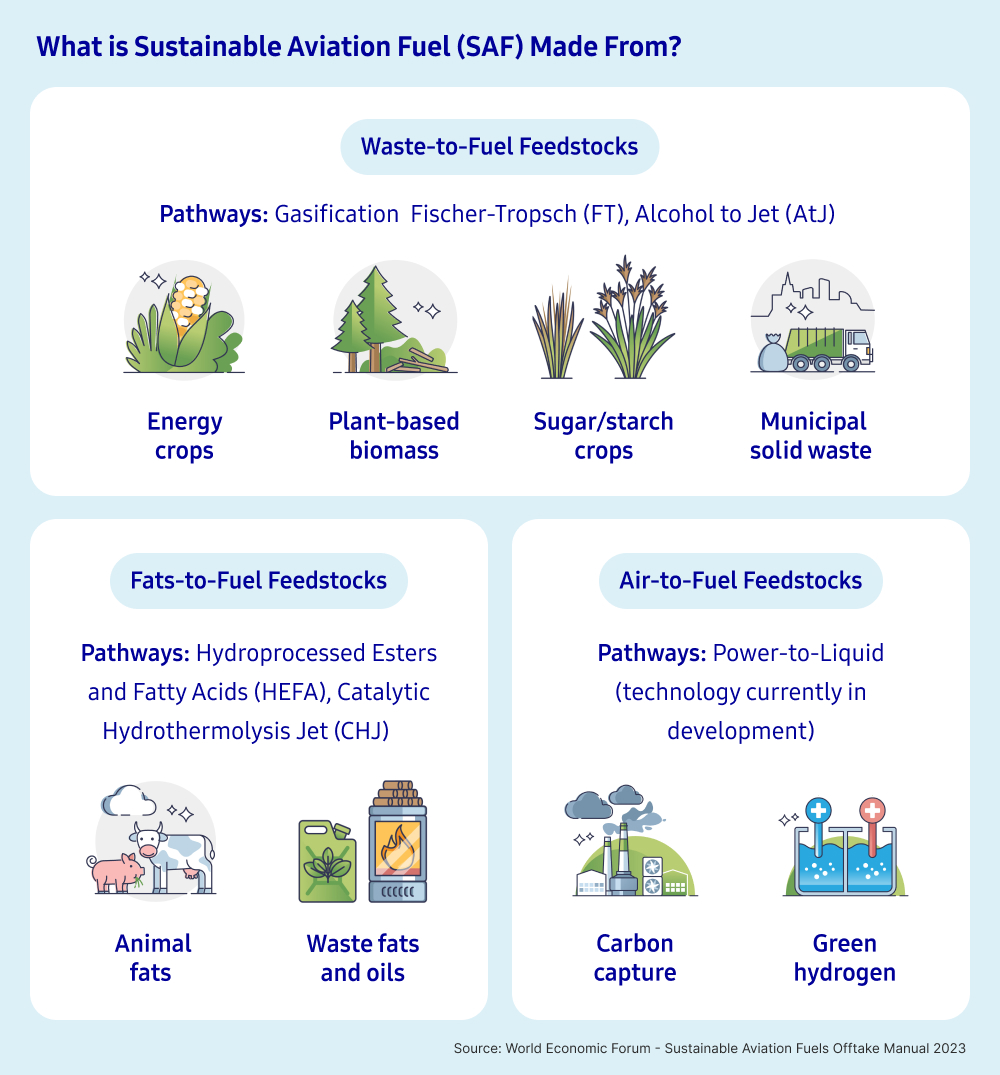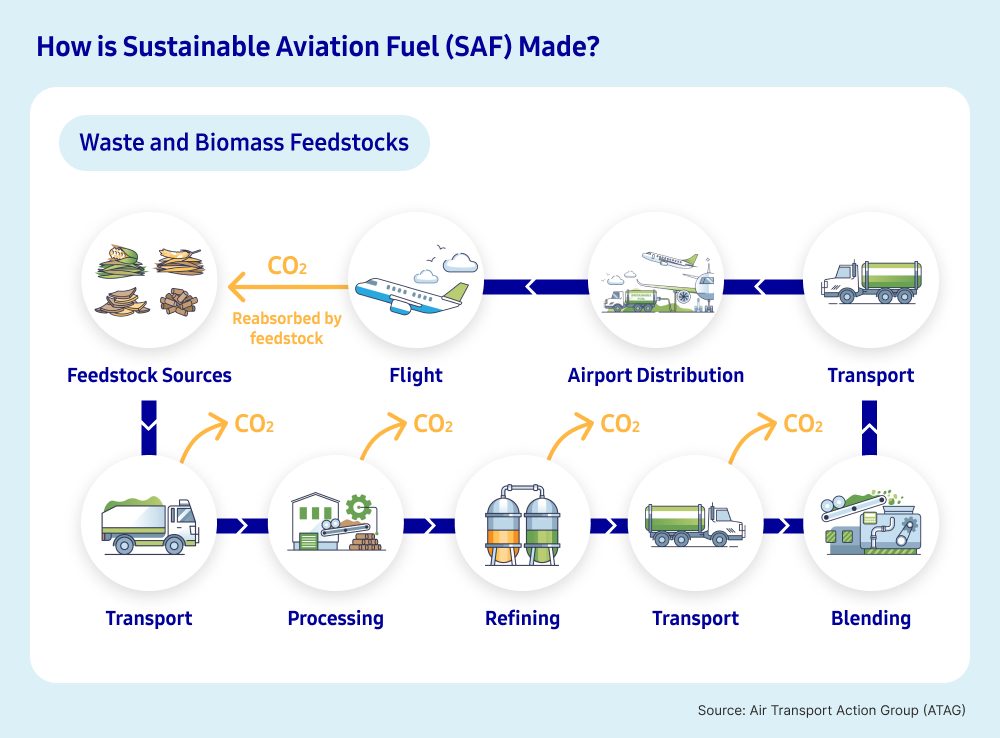Sustainable Aviation Fuel (SAF) is emerging as a crucial solution for reducing the aviation industry’s carbon footprint. SAF is made from waste-derived feedstocks and can significantly lower greenhouse gas emissions.

The thrill of international travel or shopping from global online retailers can sometimes make us overlook the environmental impact of the aircraft in our skies. The aviation industry accounted for 2% of global energy-related CO2 emissions in 2022. As the effects of the COVID-19 pandemic wear off and travel resumes, the International Air Transport Association (IATA) predicts that global passengers will increase by almost 4% each year over the next 20 years.
To mitigate the impacts of greenhouse gas emissions in the aviation industry, innovations such as more efficient aircraft designs and sustainable fuel alternatives are required. The International Energy Agency (IEA) believes sustainable aviation fuels will be critical in decarbonizing aviation. This article will introduce sustainable aviation fuels, how they are made, and provide an overview of how Samsung C&T’s Trading and Investment (T&I) Group is ensuring sustainability and compliance in its SAF raw material supply business.
Sustainable Aviation Fuel (SAF): What It Is and Why It Matters
The International Civil Aviation Organization (ICAO) defines Sustainable Aviation Fuel (SAF) as “renewable or waste-derived aviation fuels that meet sustainability criteria.” This criterion is based on the type of feedstock, the process by which the feedstock is converted into fuel, and the fuel’s sustainability certifications.
SAF is made from non-petroleum-based feedstocks and has been proven to reduce the amount of greenhouse gas emissions over an aircraft’s lifecycle. According to the IATA, SAF has shown to reduce an aircraft’s CO2 lifecycle emissions by up to 80% compared to fossil fuels, accounting for the CO2 emissions generated during production.
SAFs will play a key role in addressing the challenges highlighted in Sustainable Development Goal 13, which calls for urgent action to combat climate change and its effects. If the adoption of SAF becomes widespread with adequate policies set in place, the IATA estimates that it “could contribute around 65% of the reduction in emissions needed by the aviation industry to reach net-zero in 2050.”

What is Sustainable Aviation Fuel Made From?
SAF is made from various feedstocks (raw materials), including plant-based biomass, waste fats, used cooking oil, excess wood, and household waste such as food scraps.
Some SAFs are produced with similar properties to jet kerosene and can be used as “drop-in” fuels that are mixed with traditional petroleum-based jet fuels. This means that SAFs can integrate effortlessly with existing aircraft and airport refueling infrastructure. According to the Air Transport Action Group (ATAG), airlines are currently permitted to blend conventional jet fuels with SAFs in ratios of up to 50%, with an aim to have flights fueled by 100% SAF in the future.

How is Sustainable Aviation Fuel Made?
Currently, there are seven different technical pathways to process feedstocks to make SAF. These pathways include the “Fischer-Tropsch” and “Alcohol to Jet” processes. Newer technologies such as “Power-to-Liquid” is a pathway that does not require biomass feedstocks. According to IEA Bioenergy, the HEFA pathway, which relies on waste fats and oils, is predicted to be the main pathway for SAF until 2030.

Market Demand for SAF
The use of SAF is still in its early stages and will take some time to take off. Currently, SAF accounts for less than 0.1% of all aviation fuels consumed, according to the IEA. Estimates by IATA show that SAF production could rise to 0.5% of airlines’ total fuel consumption in 2024.
Demand for fuel in the aviation industry is still dominated by fossil fuel-based jet kerosene, which contributed 800 million metric tons of CO2 emissions in 2022 according to the IEA. In 2021, 100 million liters of SAF were produced, which increased to 300 – 450 million liters in 2022 according to IEA Bioenergy. In 2023, the IATA estimates that the airline industry consumed 450,000 to 500,000 tons of SAF in 2023. Trends in recent years show an increase in demand and increased policies implementing SAF regulations will help these numbers grow in years to come.
Challenges Remain for Decarbonizing the Aviation Industry
One challenge the market is facing is the considerable cost of SAF compared to conventional jet fuel. In November 2023, jet fuel was priced at $2.85 USD per gallon and SAF was $6.69 USD per gallon, more than double the cost. For context, a standard plane carrying over 500 passengers uses up to 36,000 gallons (150,000 liters) over a 10-hour flight. Further government support and mandates will be required to ensure SAF adoption doesn’t fall short in the coming years due to high costs.

Global Targets and Policies for SAF Worldwide
Advanced technologies like SAF that reduce carbon emissions and promote sustainability need strong policies and legislation to ensure they can be implemented effectively and responsibly.
In 2022, 184 countries agreed on a net-zero international aviation emissions target for 2050 with the International Civil Aviation Organization (ICAO), a specialized agency of the United Nations. According to the IEA, in 2022, the United Kingdom pledged GBP 165 million to support SAF projects while the United States allocated USD 3.3 billion to scaling up sustainable SAF production under its Inflation Reduction Act. France, Sweden, Norway, Japan, and China also have set targets for increasing the use of SAF.
Samsung C&T T&I's Sustainable Aviation Fuel Raw Materials Business
The Samsung C&T T&I Group is promoting a project to supply biomass derived from palm oil production (POME, PFAD, etc.) to SAF producers.
Earlier this year, Samsung C&T’s T&I Group obtained two types of ISCC certifications for its feedstock supply business for sustainable aviation fuel producers. The first is the International Sustainability and Carbon Certification (ISCC) Carbon Offsetting and Reduction Scheme for International Aviation (CORSIA) certification developed by ICAO. More commonly known as ISCC CORSIA, this certification aims to mitigate carbon emissions in the aviation industry.
The T&I Group also obtained the ISCC EU certification which is a mandatory standard for biofuels in the European Union to demonstrate compliance with the sustainability and greenhouse gas emissions savings criteria of the Renewable Energy Directive (RED II).
The Samsung C&T T&I Group is committed to sourcing clean and sustainable raw materials by leveraging its palm product sourcing network. The T&I Group also promotes sustainable growth by exploring various business opportunities in collaboration with reliable partners and is strengthening its market competitiveness as a response to the global energy transition in the era of carbon neutrality.









